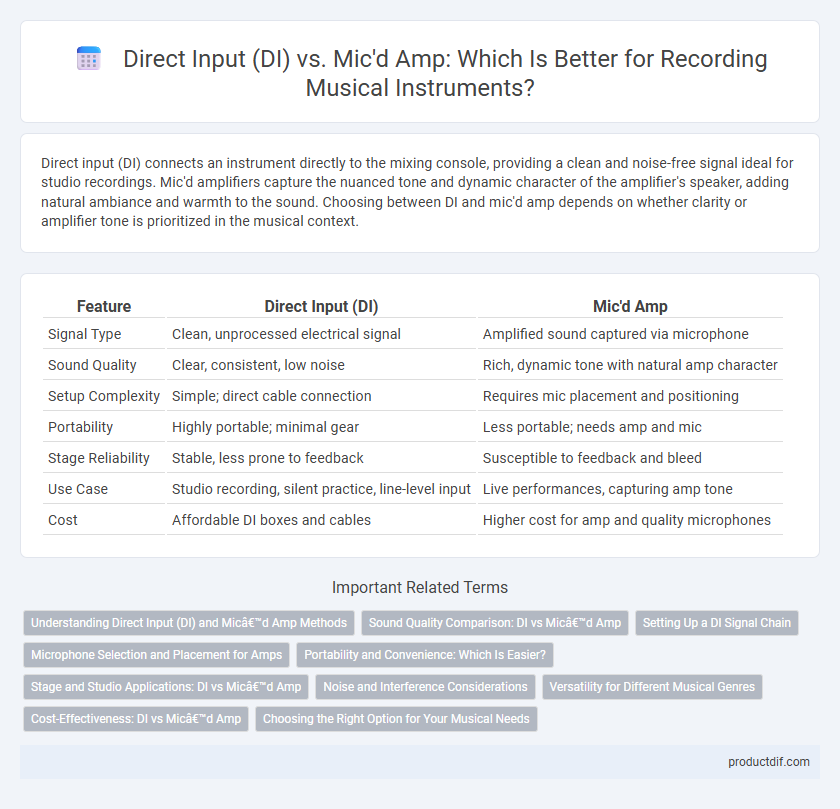Direct input (DI) connects an instrument directly to the mixing console, providing a clean and noise-free signal ideal for studio recordings. Mic'd amplifiers capture the nuanced tone and dynamic character of the amplifier's speaker, adding natural ambiance and warmth to the sound. Choosing between DI and mic'd amp depends on whether clarity or amplifier tone is prioritized in the musical context.
Table of Comparison
| Feature | Direct Input (DI) | Mic'd Amp |
|---|---|---|
| Signal Type | Clean, unprocessed electrical signal | Amplified sound captured via microphone |
| Sound Quality | Clear, consistent, low noise | Rich, dynamic tone with natural amp character |
| Setup Complexity | Simple; direct cable connection | Requires mic placement and positioning |
| Portability | Highly portable; minimal gear | Less portable; needs amp and mic |
| Stage Reliability | Stable, less prone to feedback | Susceptible to feedback and bleed |
| Use Case | Studio recording, silent practice, line-level input | Live performances, capturing amp tone |
| Cost | Affordable DI boxes and cables | Higher cost for amp and quality microphones |
Understanding Direct Input (DI) and Mic’d Amp Methods
Direct Input (DI) captures a clean, unaltered signal from an instrument by bypassing amplifiers and microphones, preserving tonal clarity and reducing background noise for more precise sound control during recording and live performances. Mic'd amp methods involve placing a microphone close to the amplifier speaker, capturing the natural coloration and dynamic response of the amp, resulting in a richer, more organic tone that reflects the amplifier's unique characteristics. Choosing between DI and mic'd amp depends on the desired sound texture, recording environment, and production needs, with DI favoring clarity and flexibility, while mic'ing amps emphasizes authenticity and ambiance.
Sound Quality Comparison: DI vs Mic’d Amp
Direct input (DI) captures the pure signal from an instrument, offering a clean, noise-free sound ideal for studio mixing and precise tonal control. Mic'd amp sound provides natural resonance, ambiance, and the subtle harmonic distortions of the amplifier and speaker, enhancing warmth and character in live and recorded performances. Sound quality comparison reveals DI excels in clarity and consistency, while mic'd amps deliver richer, organic textures preferred by many musicians.
Setting Up a DI Signal Chain
Setting up a DI signal chain involves connecting an electric instrument directly to the mixing console or audio interface, providing a clean, uncolored sound with reduced noise and interference. Unlike mic'd amp setups, DI eliminates room acoustics and microphone placement variables, ensuring a consistent signal ideal for recording or live sound reinforcement. Key components include a high-quality DI box, balanced cables, and proper gain staging to preserve signal integrity throughout the chain.
Microphone Selection and Placement for Amps
Microphone selection and placement for amplifiers critically influence tonal quality and clarity in recording instruments. Dynamic microphones like the Shure SM57 are preferred for close-miking guitar amps due to their durability and midrange presence, while condenser microphones capture more ambient detail when placed farther. Positioning the microphone near the speaker cone's edge yields warmer sounds, whereas placement at the center emphasizes brightness and attack, affecting the amp's sonic character profoundly.
Portability and Convenience: Which Is Easier?
Direct input (DI) offers superior portability and convenience by eliminating the need for bulky amplification equipment and complex microphone setups, making it ideal for musicians on the go. Mic'd amps require careful placement, stands, and cabling, which can be cumbersome and time-consuming during setup and transport. Musicians favor DI boxes for streamlined gigging and recording due to their compact size and straightforward connection to mixing consoles or audio interfaces.
Stage and Studio Applications: DI vs Mic’d Amp
Direct input (DI) captures a clean, noise-free signal ideal for studio recordings and live stage setups where clarity and consistency are crucial, especially for bass guitars and electric instruments. Mic'd amps add natural room ambiance and tonal character favored in both studio environments seeking authentic sound textures and live performances wanting dynamic presence. Combining DI and mic'd amp methods often provides the best of both, balancing pristine signal integrity with rich, organic amplifier nuances.
Noise and Interference Considerations
Direct input (DI) eliminates the ambient noise and interference commonly associated with mic'd amps by sending a clean, uncolored signal directly to the mixing console or audio interface. Mic'd amps, while offering natural amp tone and room ambiance, are prone to picking up unwanted sounds such as hums, buzzes, and environmental noise. Using balanced DI boxes and high-quality cables further reduces ground loops and electromagnetic interference, improving overall audio clarity in both live and studio settings.
Versatility for Different Musical Genres
Direct input (DI) systems offer clean, consistent signals ideal for electronic genres, while mic'd amps capture the nuanced tonal characteristics crucial for rock, blues, and jazz performances. DI provides easy integration with digital interfaces and effects, enhancing versatility in studio and live settings across pop and electronic music. Mic'd amps deliver organic warmth and dynamic range, making them indispensable for genres requiring authentic amplifier tone and stage interaction.
Cost-Effectiveness: DI vs Mic’d Amp
Direct input (DI) offers cost-effectiveness by eliminating the need for microphones, stands, and soundproofing, reducing overall setup expenses for musicians and recording engineers. Mic'd amps require investment in quality microphones, placement equipment, and sometimes dedicated rooms or spaces to avoid interference or noise, increasing costs. Choosing DI minimizes maintenance and equipment replacement costs, making it an economical solution for both studio and live performance settings.
Choosing the Right Option for Your Musical Needs
Choosing between Direct Input (DI) and mic'd amp depends on your musical style and sound preference. DI offers a clean, noise-free signal ideal for recording and live performances requiring clarity and consistency, while mic'd amps capture the natural tone and ambiance of the amplifier, providing richness and depth favored in genres like rock and blues. Assessing the acoustic environment, desired tonal character, and stage setup ensures selecting the most effective method for your unique musical expression.
Direct input (DI) vs Mic’d amp Infographic

 productdif.com
productdif.com